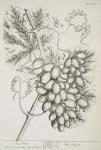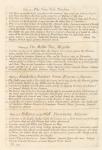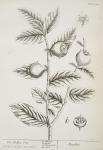

 153. The Vine. Vitis, Vinifera.
153. The Vine. Vitis, Vinifera.
1. The Vines generally differ according to the Countries they grow in, both in Height and Fruit; this Vine is the Uvae passae majores, or Raisins of the Sun.
2. This Vine is a Native of the warm Countries as Spain, Portugal, Italy and France; it flowers in April and the Grapes are ripe in the latter End of Summer.
3. Wine is accounted cordial, strengthens the Stomach, helps Digestion, comforts ye Bowels, and is a great Preservative against the Plague. The Raisins of the Sun are made by cutting the Stalks of the Branches, when on the Tree almost in two, by which means they hinder the sap from coming to them in so great a Quantity as it would do other ways, till by the Heat of ye Sun, & Defect of Nourishment they are sufficiently cured.
4. Greek, Αμνοελος οινοφορος. Latin, Vitis, Vinifera. Spanish, . Italian, The Vinifera. French, Vigne. German, Weinreb. Dutch, .

 154. The Medlar Tree. Mespilus.
154. The Medlar Tree. Mespilus.
1. It grows as big as an Apple Tree; the Leaves are grass Green; the Flowers white, and the Fruit when ripe of a brownish Green.
2. It is planted in Gardens; flowers in May, and the Fruit is ripe in November.
3. Medlars are esteem'd cooling, drying and binding (especially before they are quite ripe) and are useful in all Kinds of Fluxes. Some commend the Hard Seed as good for ye Gravel and Stone. They are an Ingredient in the Syrupus Mirtinus.
4. Greek, Μεσπιλοσ η μεμοκιλη. Latin, Mespilus sativa. Spanish, Nesper. Italian, Nespolo. French, Nesplier. German, Nespel. Dutch, .

 155. Kneeholm or Butcher's-broom. Bruscus or Ruscus.
155. Kneeholm or Butcher's-broom. Bruscus or Ruscus.
Also see #128. Horse Tongue, or Double Tongue - #154. Kneeholm or Butcher's-broom - 194. The Bay of Alexandria
1. The Stalks grow to be a Foot high, the Leaves are a deep Green, the Flowers Yellow with a purple Umbel in the Middle, and the Berries red.
2. It grows in Hedges and Thickets, particularly on Epping Forrest, and flowers for several Months in the Summer.
3. The Root is one of the five Opening Roots, and is accounted good for Obstructions of the Liver and Spleen, the Jaundice and Dropsy. It is a strong Diuretic, provokes Urine, helps the Gravel and Stone, and brings down the Catamenia.
Tournefort commends a conserve of the Berries to stop a Gonorrhea.
4. Greek, Μυγδινη αγσια & Οξυμυγσινη. Latin, Oxymirsine. Spanish, Jus barba, and Gil barbera. Italian, Brusco & Pongitopi. French, Brus. German, Brusch Ressdorn. Dutch, .

 156. Pellitory of the Wall. Parietaria, Helxine.
156. Pellitory of the Wall. Parietaria, Helxine.
1. It grows to be Eight Inches high, the Leaves are a dark Green, and ye Flowers red before they are full blown, and white afterwards.
2. It grows upon old Walls, and flowers in May.
3. The whole Herb is used being cooling opening and cleansing, containing a nitro sulphureous Salt, which recommends it for the Stone, Gravel, Stoppage and Heat of Urine; for which Ends the Juice or Decoction is given at the Mouth, and in Glisters. Some commend it for Coughs.
4. Greek, Ελξινη η σπεοδικιον. Latin, Helxine. Spanish, Yerva del muro. Italian, Vetriola. French, Paritoire. German, Zagund Racht. Dutch, .

